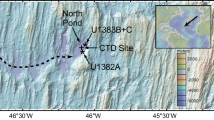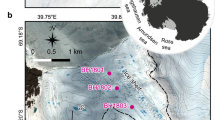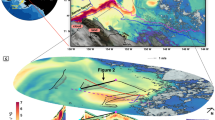Abstract
Convincing evidence exists for the large-scale convection of sea water through the upper oceanic crust, even at considerable distances from mid-ocean ridges1,2. There has been considerable interest in verifying the existence of convective overturn of pore fluid in large sedimentary basins, a mass-transport process which could profoundly influence the transport of heat, hydrocarbons, metals and diagenetically reactive dissolved constituents3,4. The existence of fluid convection in sediments of the United States Gulf Coast has been inferred on the basis of the large volumes of fluid necessary to account for the observed diagenetic alteration5 and the existence of thermal anomalies that cannot be explained by simple conductive transport of heat3,6. Theoretical Rayleigh–Darcy calculations6,7 support the notion that thermally driven convection is possible. Here I present geochemical and physical evidence for the existence of density inversions in Gulf Coast pore fluids sufficient to drive large-scale convective fluid flow at rates conceivably as high as metres per year. The density inversions are caused in part by the dissolution of salt diapirs and the formation of dense, saline brines at shallow depths.
This is a preview of subscription content, access via your institution
Access options
Subscribe to this journal
Receive 51 print issues and online access
$199.00 per year
only $3.90 per issue
Buy this article
- Purchase on Springer Link
- Instant access to full article PDF
Prices may be subject to local taxes which are calculated during checkout
Similar content being viewed by others
References
1. Anderson, R, N., Langseth, M. G. & Sclater, J. C. /. geophys. Res. 82, 3391–3409 (1977). 2. Williams, C. F., Naramsimhan, T. N., Anderson, R. N., Zoback, M. D. & Becker, K. J. geophys. Res. 91, 4877–4899 (1986). 3. Aziz, K., Bories, S. A. & Combarnous, M. A. /. Can. Petrol. Technol. 12, 41–47 (1973). 4. Cassan, J. P., Garcia Palacios, M., Fritz, B. & Tardy, Y. Bull. Cent. Rech. Elf–Aquit. 5, 113–135 (1981). 5. Land, L. S. Mem. Am. Ass. Petrol Geol. 37, 47–62 (1984). 6. Blanchard, P E. & Sharp, J. M. Trans. S.W. Sect. Am. Ass. Petrol. Geol. 6–12 (1985). 7. Wood, J. R. & T. A. Geochim. cosmochim. Acta 46, 1707–1713 (1982). 8. Workman, A. L. & Hanor, J. S. Trans. Gulf Coast Ass. geol. Soc. 35, 293–300 (1985). 9. Carothers, W. W. & Kharaka, Y. K. Bull. Am. Ass. Petrol. Geol. 62, 2441–2453 (1978). 10. Surdam, R. C., Boese, S. & Crossey, L. J. Mem. Am. Ass. Petrol. Geol. 37, 127–149 (1984). 11. Hanor, J. S. & Workman, A. L. Appl. Geochem. 1, 37–46 (1986). 12. Posey, H. H., Workman, A. L., Hanor, J. S. & Hurst, S. D. Trans. Gulf Coast Ass. geol. Soc. 35, 261–268 (1985). 13. Hanor, J. S., Bailey, J. E., Rogers, M. C. & Milner, L. R. Trans. Gulf Coast Ass. geol. 36, 143–149 (1986). 14. Garven, G. & Freeze, R. A. Am. J. Sci. 284, 1085–1124 (1984). 15. Hubbert, M. K. Trans. Am. Inst. Min. Metall. Petrol. Engrs 207, 222–239 (1956). 16. Bennett, S. & Hanor, J. S. in Dynamical Geology of Salt and Related Structures (eds Lerche, I. & O'Brien, J. J.) 425–440 (Academic, New York, 1987). 17. Bjorlykke, K. Mem. Am. Ass. Petrol Geol. 37, 277–288 (1984). 18. Bebout, D. G. & Gutierrez, D. R. Proc. U.S. Gulf Coast Geopress.–Geotherm. Energy Conf. 5, 13–24 (eds Bebout, D. G. & Bachman, A., Louisiana State Univ., Baton Rouge, 1981). 19. Hanor, J. S. Trans. Gulf Coast Ass. geol. Soc. 34, 55–61 (1984).
Author information
Authors and Affiliations
Rights and permissions
About this article
Cite this article
Hanor, J. Kilometre-scale thermohaline overturn of pore waters in the Louisiana Gulf Coast. Nature 327, 501–503 (1987). https://doi.org/10.1038/327501a0
Received:
Accepted:
Issue Date:
DOI: https://doi.org/10.1038/327501a0
This article is cited by
-
Role of hydrodynamic factors in controlling the formation and location of unconformity-related uranium deposits: insights from reactive-flow modeling
Hydrogeology Journal (2017)
-
Modeling coupled convection and carbon dioxide injection for improved heat harvesting in geopressured geothermal reservoirs
Geothermal Energy (2016)
-
Geochemistry of pore water and associated diagenetic reactions in the diapiric area of Yinggehai Basin, northwestern South China Sea
Journal of Earth Science (2015)
-
Salinization problems in the NEGB: results from thermohaline simulations
International Journal of Earth Sciences (2008)
-
Horizontal flow of pore fluids
Nature (1990)
Comments
By submitting a comment you agree to abide by our Terms and Community Guidelines. If you find something abusive or that does not comply with our terms or guidelines please flag it as inappropriate.



